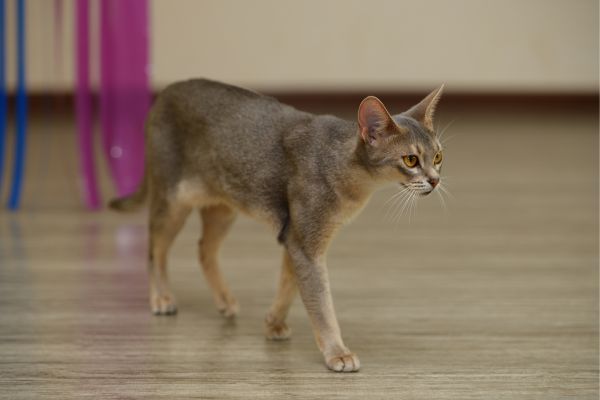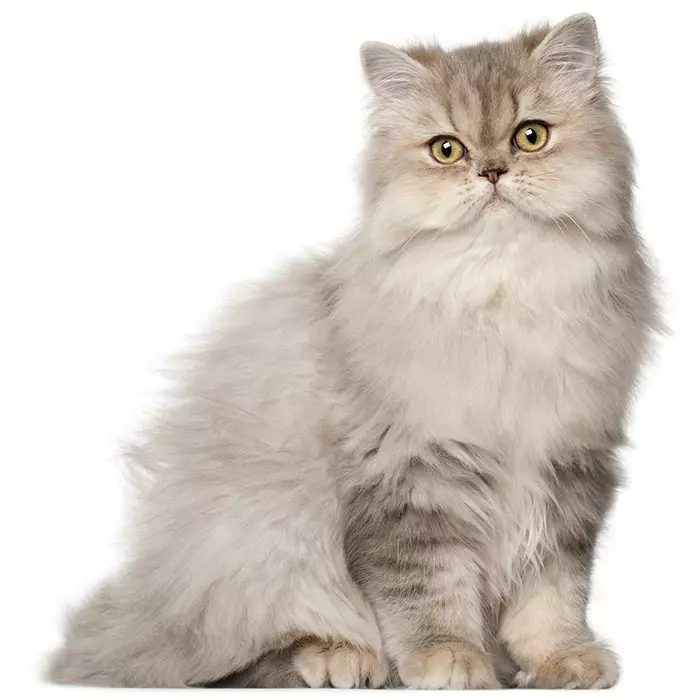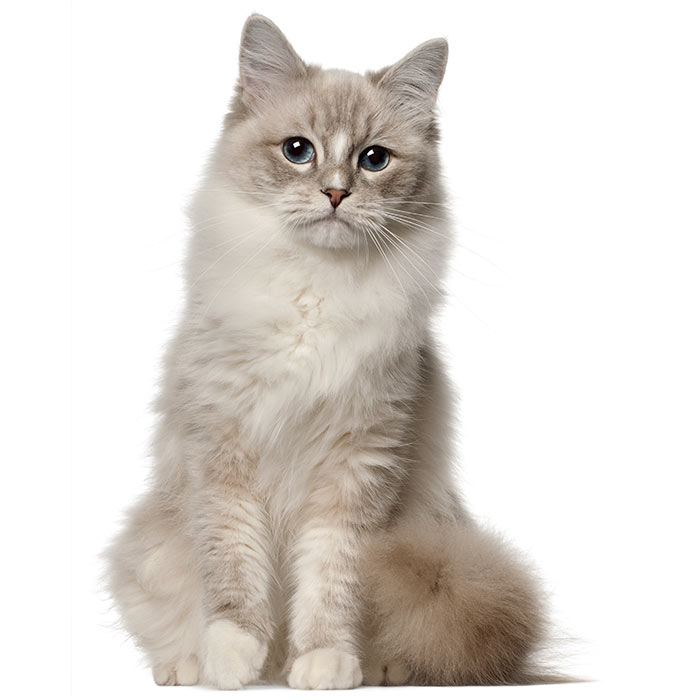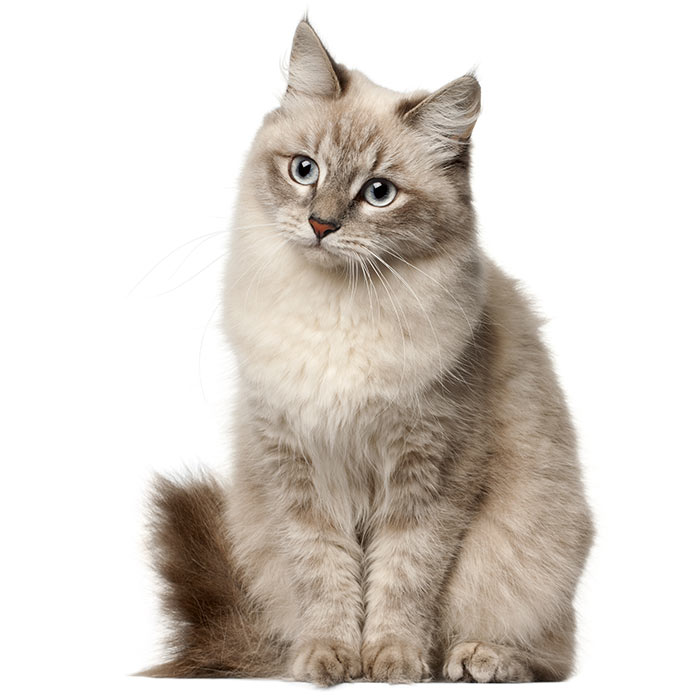Abyssinian
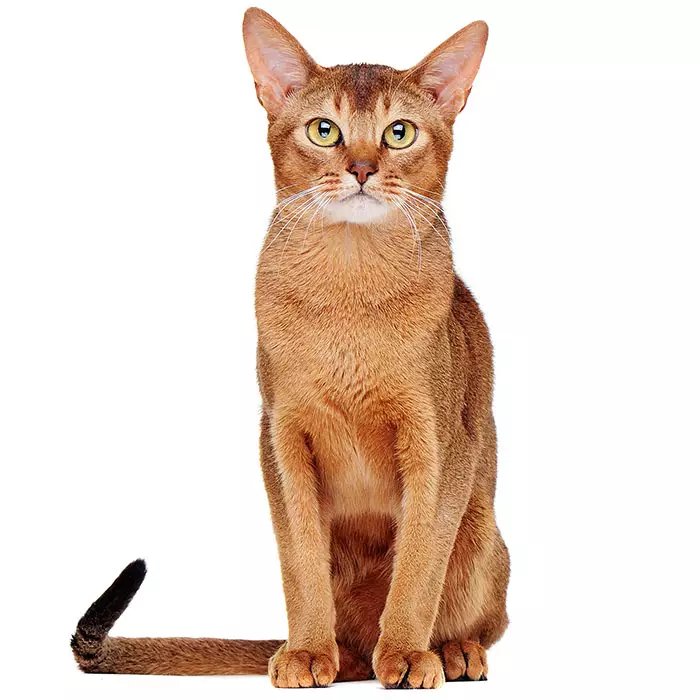

| Recommended for | Active families or individuals in homes with space to play and interact |
| Breed Classification | Shorthair |
| Other names | Aby |
| Lifespan | 12 to 16 years |
| Size | Medium |
| Temperament | Playful, affectionate, energectic |
| Intelligence | Highly intelligent, quick learner; enjoys problem-solving activities |
| Tendency to vocalise | Generally quiet; occasional soft chirps, trills and purrs |
| Maintenance Level | Low grooming needs, requiring occasional brushing and regular exercise to stay healthy |
| Health Risk | While generally healthy and long-lived, breed specific health risks include PRA, PKD, dental issues, and kidney disease. |
Insuring an Abyssinian?
Get our award-winning Nose-to-Tail Cover with up to $30k annual benefit limit, up to 90% of eligible vet bills back, and no sub-limits.
Get a quick quote
Is this breed right for you?
Try our breed selector quiz to find out your best matching breed!
Insuring an Abyssinian?
Get our award-winning Nose-to-Tail Cover with up to $30k annual benefit limit, up to 90% of eligible vet bills back, and no sub-limits.
Get a quick quote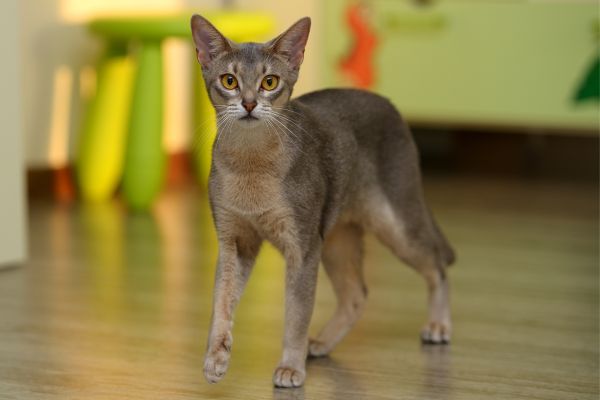
Breed history of Abyssinians
The Abyssinian cat, despite its name and common belief, did not originate in Abyssinia (now Ethiopia). Possibly one of the oldest domestic cat breeds, its ancestry may date back to ancient Egypt, where cats resembling Abyssinians were featured in ancient papyri and tomb paintings. Recent genetic research points to cats with similar traits being common in the Indian Ocean basin, particularly coastal parts of India, Sri Lanka, and Southeast Asia.
The Abyssinian has been known in Britain for well over 100 years, making it one of the oldest established breeds there. Despite a lack of official records, there is anecdotal evidence that Mrs Barrett-Lennard, wife of an army captain, brought a cat named Zula into Britain from Abyssinia in 1868.
Despite its ancient lineage, the modern Abyssinian breed was developed through selective breeding efforts in Britain during the late 19th and early 20th centuries. World War II almost decimated the breed in Europe; fortunately, it had spread to the safe havens of America and Canada by then. The breed is believed to have first appeared in Australia during the 1950s, most likely from the UK.
Abyssinians as a breed suffered a major setback in the 1970’s, with many British lines falling victim to FeLV. The threat of extinction was overcome as a result of Aby clubs working together to recommend a policy of testing and isolation, thus eliminating the disease while there were still enough Abys left to breed from. Today, the Abyssinian, with its sleek, wildcat-like appearance and lively, intelligent personality, has become one of the most popular and well-known shorthaired breeds worldwide.
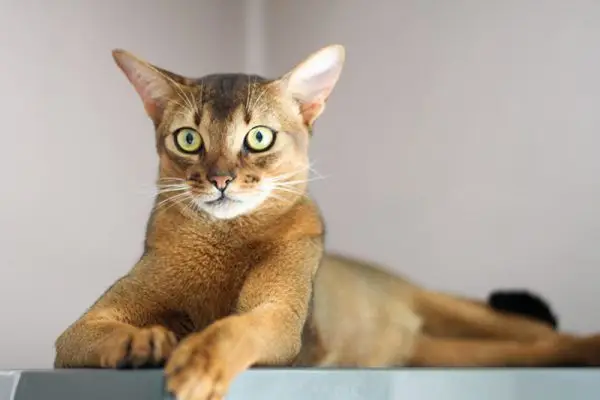
Physical description of Abyssinians
The Abyssinian is a medium-sized cat with a sleek, muscular build. They have large, almond-shaped eyes that can be gold or green, and their ears are large and pointed, adding to their expressive, alert look. Their long, tapered tail contributes to their graceful appearance and allows them to move with agility.
One of the most distinctive traits of the Abyssinian is its short, “ticked” coat. This means that each and every hair has bands of different colours, giving the coat a shimmering, exotic appearance.. The darkest shades are near the skin while the lighter shades can be found at the tips. The most iconic Abyssinian coat colour is a rich golden-brown base with black or dark brown ticking, known as ‘ruddy’.
| Weight range | Males: 4.5 to 5.5 kg, females 3.5 to 4.5 kg |
| Height range | 23 to 28 cm (9 to 11 inches) at the shoulder |
| Colours | Ruddy, sorrel (cinnamon), blue, fawn |
| Coat length | Short |
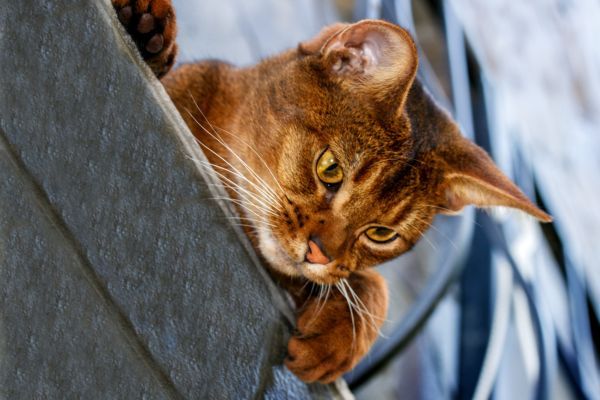
Abyssinian personality and temperament
The Abyssinian is an intelligent, friendly, playful, and curious breed. Affectionate without being overly clingy, they usually form strong bonds with their families. They are sociable and outgoing cats that enjoy interaction with people and other animals. Abys are quick learners and easy to care for, making them well-suited to first-time cat owners. Both independent and affectionate, they enjoy attention but will also happily entertain themselves.
Abys have high energy levels and are ideal for active households where they can engage in plenty of physical and mental stimulation. They love to explore, climb, and play, so they need space to move around and engage in challenging activities. They are not lap cats as they don’t sit still for very long, but they have no problem playing with their own toys for an entire afternoon. Then, just like that, they can shift their attention to people and other animals for interactive play.
Their curious and active nature means they enjoy exploration, and if allowed outdoors, they may try to roam or explore beyond the home. However, to ensure safety and prevent injury, Abyssinians are best suited to indoor living environments with plenty of opportunities to engage in play and mental stimulation. If allowed outside, supervised outdoor access or a secure cat enclosure is ideal to satisfy their adventurous spirit.
The Abyssinian is generally a quiet breed, but they are not completely silent. They tend to communicate with a soft voice, typically when they want attention or are in the middle of play. Common sounds they make include soft chirps or trills, especially when they are excited or curious. They may also purr softly when content, particularly when being petted or when they are feeling affectionate.
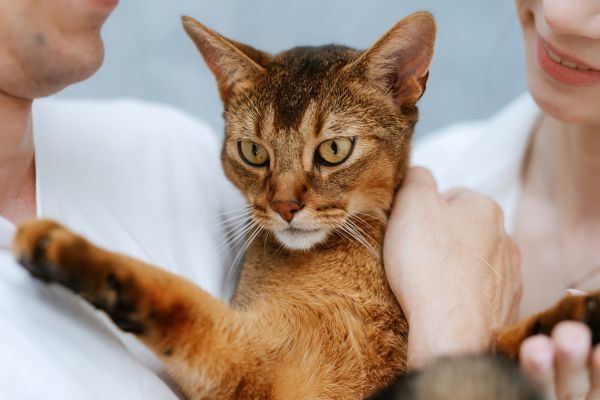
Abyssinians with kids and other pets
Abyssinians generally get along well with children, especially those old enough to interact gently with them.
They are social and adaptable, forming bonds with other pets, including cats and dogs, provided they are introduced properly.
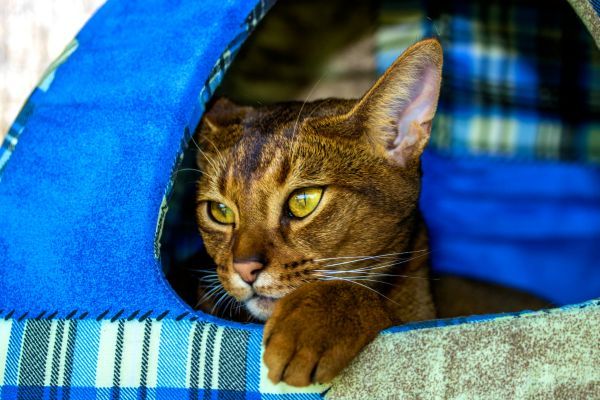
Abyssinian training and exercise
Abyssinians are an active and energetic breed, so they need plenty of exercise to stay healthy and happy. Despite their high energy, they can adapt well to indoor life as long as they receive sufficient mental and physical stimulation. Interactive play is important for mental stimulation, with toys like puzzle feeders, laser pointers, and feather wands being great choices.
Often referred to as the “gymnasts” of the cat world due to their exceptional agility, Abys love climbing, so providing cat trees or shelves will allow them to burn off energy while satisfying their natural climbing instincts. Daily play sessions and opportunities for exploration will help keep them physically and mentally stimulated.
Abys are known for their quick wit and can be trained to fetch, perform tricks, and solve puzzles.
| Energy level | High |
| Exercise requirements | Plenty of opportunities for interactive play and physical and mental challenges |
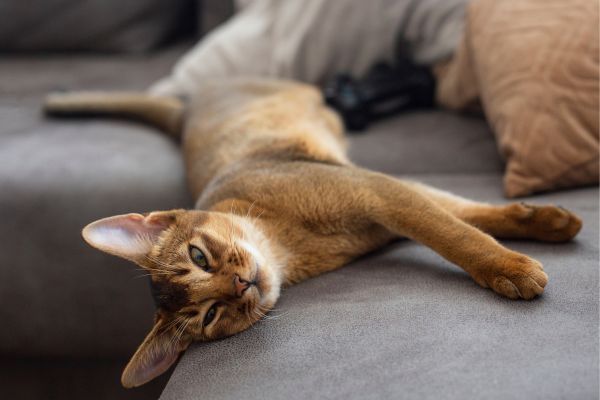
Abyssinian feeding and nutrition
The Abyssinian thrives on a balanced diet that supports its active lifestyle. High-quality, protein-rich food is ideal for this energetic breed. Dry kibble and wet food, particularly those with high meat content, help maintain muscle mass and overall health. It’s important to feed Abyssinians a combination of both wet and dry food to ensure hydration and digestive health. Opt for food that contains essential fatty acids, vitamins, and minerals to support their coat and general well-being.
Portion control is key to avoid overfeeding, as Abyssinians tend to have a healthy appetite. Their food intake should be divided into two or three meals a day to prevent obesity. Regular feeding schedules and fresh water should always be available to keep them hydrated. Consulting with your vet for specific dietary recommendations based on your Abyssinian’s age, activity level, and health condition is also a good practice.
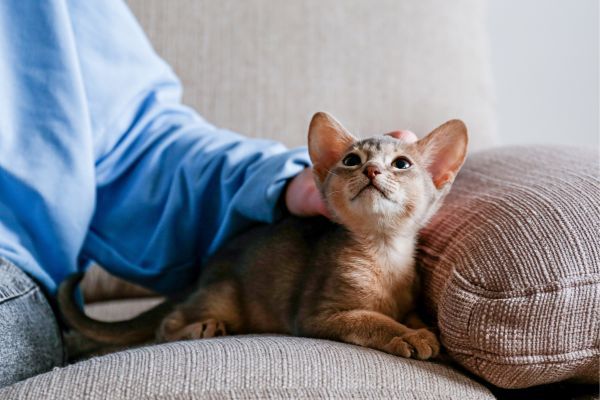
Abyssinian care and grooming
The Abyssinian has a short, dense coat that requires minimal grooming. Regular brushing once a week is usually sufficient to remove loose hairs and reduce shedding. While they don’t need extensive grooming, they do benefit from occasional baths to keep their coat in top condition.
Regular ear cleaning and nail trimming should be part of the grooming routine to ensure overall health. As with all cats, dental care is essential, so brushing their teeth regularly or providing dental treats is recommended. In cooler climates, extra warmth may be necessary, as they aren’t naturally equipped for very cold conditions.
Health issues for Abyssinians
- Kidney Disease can affect Abyssinians, particularly as they age. Symptoms include increased thirst, frequent urination, and weight loss. Early detection through regular vet visits is key to managing the condition, and the breed may be more susceptible as they get older.
- Progressive Retinal Atrophy (PRA) is a genetic condition that can cause degeneration of the retina, leading to progressive vision loss and blindness. While it is not common in Abyssinians, it remains a possible concern, and symptoms can include night blindness and dilated pupils.
- Hyperthyroidism is a condition that is more commonly seen in older Abyssinians. It results from an overactive thyroid, leading to weight loss, increased appetite, and hyperactivity. This condition can be managed through medication or surgery and should be monitored in senior cats.
- Pyruvate Kinase Deficiency (PKD) is a rare hereditary blood disorder that can lead to anaemia, lethargy, and a reduced lifespan. It is inherited as an autosomal recessive trait. Regular blood tests can help detect this condition early, though it is not widespread in the breed.
- Cranial Meningocele is an uncommon condition where part of the brain protrudes through a skull defect. While rare, it can cause neurological issues and requires veterinary attention if detected.
- Dental Disease is more common in Abyssinians, particularly gingivitis, which causes gum inflammation and tooth loss. This is often linked to poor dental hygiene, so regular brushing and dental check-ups are essential to prevent its progression.
- Hip Dysplasia is rare in Abyssinians but can occur. It affects the development of the hip joint, leading to instability and arthritis. It is inherited through multiple genes and presents symptoms such as lameness, pain, and difficulty moving. Rapid growth, excessive weight, and improper exercise can worsen the condition, although it is not a major concern for this breed.
Not all conditions are covered by Pet Insurance. For details of Bow Wow Meow Pet Insurance cover, refer to the Product Disclosure Statement.
Free engraved pet ID tag on sign up3
Customer Satisfaction
21 day cooling off
Easy to use Pet Portal


